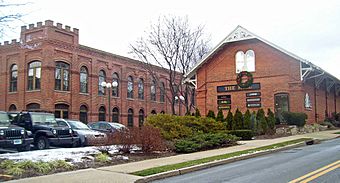Glenville Historic District facts for kids
Quick facts for kids |
|
|
Glenville Historic District
|
|

The New Mill and Depot buildings
|
|
| Lua error in Module:Location_map at line 420: attempt to index field 'wikibase' (a nil value). | |
| Location | Roughly along Glen Ridge Rd., Glenville Rd., Glenville St., Pemberwick Rd., Riversville Rd., and Weaver St., Greenwich, Connecticut |
|---|---|
| Area | 33.9 acres (13.7 ha) |
| Architectural style | Mid 19th Century Revival, Late Victorian |
| NRHP reference No. | 07000107 |
| Added to NRHP | March 9, 2007 |
The Glenville Historic District, also called Sherwood's Bridge, is a cool historic area in Greenwich, Connecticut. It covers about 34 acres. This district is super important because it shows what a New England mill village was like long ago.
It's also special because many immigrants came here. In the 1800s, many Irish families settled here. Later, in the 1900s, many Polish families arrived. Glenville is still a main home for Polish people in the town.
The district also has amazing buildings. You can see old mill buildings, a beautiful school, and interesting homes. These buildings show different styles of architecture from the past.
Contents
What Makes Glenville Special?
The Glenville Historic District was added to the National Register of Historic Places in 2007. This means it's a nationally recognized important place. When it was listed, it included 43 buildings that help tell its story. It also had 4 other structures and 4 sites that were important.
A Look at the Area
The district includes the main part of the neighborhood. It has the old mill property. However, some newer parts like a shopping center are not included. Also, some houses built in the 1960s are outside the district's special area. This helps keep the historic feel of the main part.
Important Buildings and Places
Many interesting buildings are part of the Glenville Historic District. They each have a unique story.
- One Glenville Street: This is a very important commercial building. It started smaller and was expanded in 1882. It shows the Italianate style.
- Glenville School: This school is so special that it's listed on the National Register of Historic Places all by itself! It's a great example of Georgian Revival style.
- Cornell's Castle: This is a large, fancy house built in the Queen Anne style. It looks like something out of a storybook!
- New Mill Building: Built in 1881, this mill building is in the Romanesque Revival style. It has cool details like castle-like tops and decorative patterns.
- Depot Building: Also known as the Picking Building, this was built in 1879. It has a mix of Stick style and Queen Anne designs. It was built because people thought a railroad would come through, but it never did!
- Webster Haight House: This house was built in 1872. It's a good example of an Italianate style home and is located at 25 Glenville Street.
- Pottgen House: Built in 1898, this house is another beautiful example of the Queen Anne style. You can find it at 9 Glenville Street.
- Glenville Firehouse: This fire station was built in 1950. It shows the Georgian Revival style. It's located at 266 Glenville Road.
- Concrete Arch Bridge: There's a concrete bridge from 1948 on Glenville Street. It's a cool example of engineering from that time.
- 11 Glenville Street: This Italianate house was built in 1855. John Sherwood expanded it in 1882.
The Byram River's Role
The district is located right by the falls of the Byram River. This river was super important in the past. It provided the waterpower needed to run the machinery in the mills. Without the river, Glenville might not have become the busy mill village it once was!

